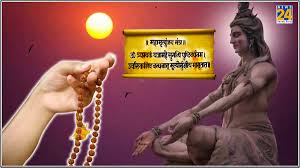
Mahamrityunjay Jaap is a powerful Hindu ritual dedicated to Lord Shiva to seek protection from untimely death, diseases, and negative energies. The puja involves the chanting of the Mahamrityunjay Mantra — “Om Tryambakam Yajamahe…” — repeatedly, accompanied by offerings and rituals. It is believed to promote health, longevity, spiritual growth, and overall well-being. This jaap is often performed on Mondays, Maha Shivratri, or any auspicious occasion for peace and divine blessings.Mahamrityunjay Jaap is a powerful Hindu ritual dedicated to Lord Shiva to seek protection from untimely death, diseases, and negative energies. The puja involves the chanting of the Mahamrityunjay Mantra — “Om Tryambakam Yajamahe…” — repeatedly, accompanied by offerings and rituals. It is believed to promote health, longevity, spiritual growth, and overall well-being. This jaap is often performed on Mondays, Maha Shivratri, or any auspicious occasion for peace and divine blessings.
• Chanting of Mahamrityunjay Mantra repeatedly for protection and health
• Worship of Lord Shiva in the form of Linga or image
• Lighting of lamps (Diya) and incense sticks (Agarbatti)
• Offering flowers, bilva leaves, and fruits to Shiva
• Performing Aarti after the jaap
• Conducted individually, at home, or in temples
• Often performed on Mondays, Pradosh, or Maha Shivratri
• Belief in removing negative energies and promoting longevity
• Can be performed for self, family, or community welfare
• Distribution of prasad after completion of jaap• Chanting of Mahamrityunjay Mantra repeatedly for protection and health@• Worship of Lord Shiva in the form of Linga or image@• Lighting of lamps (Diya) and incense sticks (Agarbatti)@• Offering flowers, bilva leaves, and fruits to Shiva@• Performing Aarti after the jaap@• Conducted individually, at home, or in temples@• Often performed on Mondays, Pradosh, or Maha Shivratri@• Belief in removing negative energies and promoting longevity@• Can be performed for self, family, or community welfare@• Distribution of prasad after completion of jaap
Samagri
• Shiva Linga or picture of Lord Shiva
• Bilva (Bel) leaves
• Flowers (white, red, or marigold)
• Fruits for offering
• Incense sticks (Agarbatti)
• Lamp (Diya) with ghee or oil
• Kalash (holy water pot)
• Coconut
• Rice grains (Akshata)
• Sandalwood paste
• Kumkum (vermilion) and turmeric
• Bell (Ghanti) and conch (Shankh)
• Panchamrit (milk, curd, honey, ghee, sugar)
• Holy water (Ganga jal)
• Cloth or decorative fabric for altar• Shiva Linga or picture of Lord Shiva@• Bilva (Bel) leaves@• Flowers (white, red, or marigold)@• Fruits for offering@• Incense sticks (Agarbatti)@• Lamp (Diya) with ghee or oil@• Kalash (holy water pot)@• Coconut@• Rice grains (Akshata)@• Sandalwood paste@• Kumkum (vermilion) and turmeric@• Bell (Ghanti) and conch (Shankh)@• Panchamrit (milk, curd, honey, ghee, sugar)@• Holy water (Ganga jal)@• Cloth or decorative fabric for altar
Mahamrityunjay Jaap
Pay Now
Change of Plan ? Kalkipuja has you covered !
Cancel upto 48 hours before event & get full refund OR reschedule with ease


